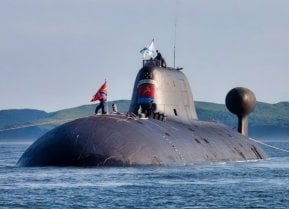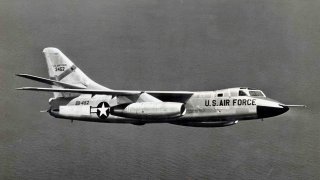The Douglas B-66 'Destroyer' Bomber Was a Real Powerhouse
The Douglas B-66, nicknamed "the Destroyer," was a light bomber adapted from the U.S. Navy's A-3 Skywarrior for the U.S. Air Force.
Summary: The Douglas B-66, nicknamed "the Destroyer," was a light bomber adapted from the U.S. Navy's A-3 Skywarrior for the U.S. Air Force. Primarily serving as an electronic support aircraft during the Cold War and Vietnam War, the B-66 underwent extensive modifications from its naval counterpart, including a redesign of the fuselage, wings, and engines.
Despite its origins as a simpler version of the A-3, the B-66 evolved into a distinct aircraft capable of low-level operations, featuring new avionics, ejection seats, and different landing gear.
It reached speeds up to 630 mph with a combat range of 900 miles.
Douglas B-66 in Focus: From Naval Design to Iconic Air Force Support Aircraft
Named “the Destroyer” (despite never destroying anything), the Douglas B-66 was a light bomber derived from the A-3 Skywarrior and built for the U.S. Air Force. While the A-3 was a carrier-based attack aircraft (built for the U.S. Navy), the B-66 was land-based. The B-66 served mainly as an electronic support aircraft rather than a bomber during the Cold War and Vietnam War.
Initially, the B-66 was conceived as a simpler version of the A-3—without the naval components required for carrier operations. However, the Air Force eventually developed such extensive and divergent requirements that significant alterations were made to the A-3 base design, resulting in much of the B-66 being of the original design.
Developing the B-66 Bomber
As the U.S. Navy developed the A-3, the Air Force took notice. Why? The A-3 demonstrated that a relatively small aircraft could conduct mission profiles similar to larger aircraft like the B-47 Stratojet. Particularly, the aircraft had an unrefueled combat radius of 1,000 miles, which, along with the fact that the Navy had already paid development costs for the A-3, made the model attractive to the U.S. Air Force. So, during the 1950s, the U.S. Air Force began pursuing a land-based variant of the A-3.
The plan had been to remove the carrier-specific features of the A-3 and install Air Force-specific avionics while otherwise just sticking with the A-3’s original design. That was the plan anyway. Over time, in an effort to meet evolving U.S. Air Force requirements, the B-66 became an aircraft distinct from the A-3.
Many of the changes, from A-3 to B-66, resulted from the Air Force’s wish that the B-66 perform low-level operations. The A-3, having been developed to do the exact opposite—high-altitude nuclear strike missions—was ill-suited for low-level operations and required the overhaul the Air Force intended to avoid.
According to some, that’s debatable. Aviation writers Bill Gunston and Peter Gilchrist have argued that the changes were made “merely to be different” and were a result of the rivalry between the U.S. Air Force and U.S. Navy and that “an objective assessment might conclude that 98 percent of the changes introduced to the RB-66A were unnecessary.”
Necessary or not, the fuselage and the wing were redesigned from scratch. The engines were swapped out, too; the A-3’s Pratt & Whitney J57 turbojet engines were swapped for the Allison J71. (Gunston and Gilchrist noted that the engine switch “offered no apparent advantage” as the J71 was more fuel-hungry yet offered less thrust than the J57, which the USAF already happened to use on other airframes.) And, of course, the alteration necessitated the change of the entire power system, including repositioning all hydraulic pumps and generators.
The cockpit was changed, too. The landing gear was changed. The B-66 was given ejection seats (which the A-3 lacked).
Despite the complicated redesign, the B-66 proved to be adequate and versatile. By 1956, the U.S. Air Force accepted deliveries of the new bomber, which measured seventy-five feet long with a seventy-two-foot wingspan. The jet could hit 630 miles per hour and had a combat range of 900 miles, a service ceiling of 39,400 feet, and a climb rate of 5,000 feet per minute.
Famously, an EB-66 was shot down over North Vietnam. The rescue of the crew became the subject matter for the book and film Bat*21.
About the Author: Harrison Kass
Harrison Kass is a defense and national security writer with over 1,000 total pieces on issues involving global affairs. An attorney, pilot, guitarist, and minor pro hockey player, Harrison joined the U.S. Air Force as a Pilot Trainee but was medically discharged. Harrison holds a BA from Lake Forest College, a JD from the University of Oregon, and an MA from New York University. Harrison listens to Dokken.
Image: Creative Commons.


